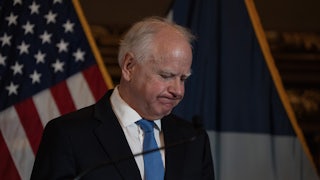Although the 118th Congress is still young, it has often been defined by rancor between the Republican-controlled House and the Democratic-majority Senate. Even within the House, lawmakers of both parties have frequently clashed, with the latest partisan struggle over raising the debt ceiling symbolic of the larger fissures within Congress. In an era of hyperpolarization, the fruits of bipartisan agreement are a rare commodity.
But hope springs eternal. Even within the divisive atmosphere of this Congress, a bipartisan group of House members is working to find a compromise on a thorny issue that has long stumped Congress: paid leave. The task force, led by Republican Representative Stephanie Bice and Democratic Representative Chrissy Houlahan, includes an even number of members of each party, all committed to finding some form of consensus.
“Our work is to find a way to provide more paid leave to more people. And it doesn’t necessarily mean that we are able to solve this problem completely with just one working group and a bunch of meetings,” Houlahan told me in an interview. “Rather, we believe that we need to try to find where our common ground is, and how we can move forward to advance this cause so that more people have access to more leave.”
Houlahan was quick to note that the group—which also includes Republican Representatives Julia Letlow and Mariannette Miller-Meeks and Democratic Representatives Haley Stevens and Colin Allred—was not a caucus. House caucuses often form around a shared ideology or commitment to policy, but Houlahan said that she and Bice believed a task force better conveyed “a sense of urgency.”
“By making sure that it’s not some sort of a caucus, which tends to be a little bit more of a gathering and less of an action-oriented kind of thing, our messaging to ourselves and to others is that this is a working group,” Houlahan continued.
The Family Medical Leave Act, signed into law 30 years ago this past February, was a revolutionary piece of workplace legislation, granting millions of Americans 12 weeks of unpaid leave with the guarantee that the worker would keep their job. But advocates considered the measure a stepping stone toward paid leave, a dream that has yet to be fulfilled. The United States remains the only wealthy country in the world without a paid, guaranteed leave policy. The National Partnership for Women and Families estimates that in 2022, 10.9 million workers needed leave but did not take it, with two-thirds of those saying they were unable to do so as they could not afford to take unpaid leave.
“Thirty years is way too long to have not taken the next step,” said Michelle Feit, the director of congressional relations for economic justice at the National Partnership for Women and Families. Progress on the issue has been incremental: For example, a measure passed during the Trump administration guaranteed paid parental leave for federal employees, but not medical leave, and there are still millions of part-time and small-business workers who do not even qualify for the basic leave offered by the FMLA. Democrats also included a paid leave provision in President Joe Biden’s massive social spending bill, the Build Back Better Act, but that legislation died in the Senate.
Feit highlighted some previously introduced pieces of legislation that would expand access to paid leave, including the Family Act, which would provide 12 weeks of paid parental and medical leave. But that measure has not yet been reintroduced in Congress, and did not have any Republican co-sponsors. “We also would love to see the working group explore ways to include access to job-protected leave, whether that’s paid or unpaid,” Feit said.
Houlahan said that the group’s goal of “more leave for more people” could come to fruition in several different ways, such as more parental leave for a greater universe of workers, or could mean “level-setting or baselining what’s available, modeled somehow on the outlines or the contours of the FMLA.”
Task force members also cautioned that their work was in its nascent stages, and it was not yet possible to give a clear picture of a finished product. “We’re not looking to shoot from the hip right out of the gate, but we’re building not only a body of knowledge but a deepening of the policy so that we can put something forward in a bipartisan way,” said Stevens.
The task force has held three meetings thus far, featuring the architects of the FMLA, representatives from states that have implemented paid leave programs, industry officials from private insurance companies. The next meeting, occurring in May, will include business leaders. “We are working to build momentum and are examining options such as those that have been implemented at the state level, tax incentives for businesses as well as individuals, and ways to engage insurance companies,” Bice said in a statement. “Over the coming months we will continue this approach and look at crafting bipartisan legislation that works for both families and businesses.”
But while bipartisanship may be the group’s strength, it also underscores the difficulties in actually reaching a consensus. As committed as the members of the task force may be, it’s unclear whether their efforts will be supported by their respective caucus leadership. Members of the task force sent a letter to Speaker Kevin McCarthy and House Minority Leader Hakeem Jeffries earlier this month, asking them to engage in the efforts to find a solution. Houlahan told me that though the group had not received “explicit encouragement” from leadership, she was heartened by “colleagues who have been receptive.”
Allred told me that he believed the “sticking points” for the agreement include the scope of any paid leave program, as well as how it would be funded. But in the wake of the coronavirus pandemic, he said, “there’s an understanding that we have to do this at some point.” Allred, the first House member to take advantage of paternity leave, added that he believed it was important to have dads be part of the conversation. “In the last few years, men are taking family leave at higher rates than ever before. But we still have a very strong stigma in the workplace against it,” Allred, a former professional football player, said. “We have to overcome that image. So if a former NFL linebacker can help break that down, then it may make it a little easier for other men to do it.”
There is also a bipartisan task force tackling paid leave in the Senate. Democratic Senator Kirsten Gillibrand told me on Wednesday that the group would meet this week, adding that their counterparts from the House are invited to the discussion. “We’re just going to keep working toward it, and see what level of consensus we can reach,” Gillibrand said.
While Congress may be focused for the moment on trenchant issues like the debt ceiling fight, Houlahan expressed hope that the work of their task force could build momentum on paid leave. She noted that the deal to grant paid parental leave to federal workers came together quickly before being included in the annual defense authorization legislation in 2020.
“I’m hoping for lightning in a bottle,” Houlahan said, “but I also am happy to do the work.”
This article has been corrected to reflect that the task force meeting with business leaders will occur in May.










